Beard Styles, Cremo's Complete Guide
- Choose the Right Style
- How To Determine Your Face Shape
- 7 Most Common Face Shapes
- Partial Beard Styles
- Short to Medium Beard Styles
- Long Beard Styles
Choose the Right Style
The ultimate goal of your beard style is to add contrast and dimension to your face. Different face shapes need to highlight certain features to get the best results. Find a style that fits how your beard naturally grows and accentuates your existing facial features. You also want your look to fit your lifestyle and the amount of time you want to put into beard maintenance.
Like choosing a haircut, there are a few factors to consider before selecting which beard style is right for you.
Ask yourself:
- What is your face shape?
- How much facial hair do you have? Does your hair grow thick or patchy?
- What amount of maintenance are you willing to commit to?
A healthy beard is the best beard, so using quality beard products and having a consistent beard care routine is essential.
Also, you will want to consider the natural thickness of facial hair. If your facial hair is thick, you’ve got styling options. You can either pick a style that is short or grown out. Patchy or thin beards are limited on beard styles. Stubble and closely cropped beards look best as long beards can look stringy and unkempt.
Why is Understanding Your Face Shape Important?
Knowing your face type allows you to play with the dimensions and proportions. This knowledge helps you determine which parts of your face to emphasize and which features to tone down. Taking the time to assess your face shape before deciding on your style goals is key in picking the most flattering beard for your face.
How to Determine Your Face Shape - 3 Steps
There are seven different face shapes: Oval, Oblong/Rectangle, Round, Square, Diamond, Triangle, and Heart. Each one has defining characteristics, bone structure, and angles. You can determine yours by breaking the face shape into three parts: the forehead and cheekbone width, jawline, and face length and comparing their measurements.
Let’s find out your face shape.
First - Evaluate the shape of your jaw
Your jawline is a significant defining feature of your face type. A short or round jaw can mean you have a round or oval face. If your jawline is pointy and narrow, most likely, your face shape is a heart or triangle. A jawline with sharp angles is a characteristic of a square face.
Second - Determine the widest part of your face
Look in the mirror and determine which part of your face is the widest. You can do this with your eyes or grab a measuring tape for a more exact dimension. The widest part varies for different face types. If your cheekbones are the widest point, your face is either round or heart-shaped. Oval and triangle head shape’s widest part is the forehead. If your forehead and cheekbones seem evenly wide, you probably have a square head shape.
Third - Take your face measurements and compare them
If you are still debating which face type, measuring the width of your forehead, cheekbones, and length of your face and jaw with a soft measuring tape can be helpful. Start by standing in front of a mirror and jotting down the measurements so you can compare them later.
Measuring Guide:

7 Most Common Face Shapes
There are seven basic face shapes: Oval, Oblong/Rectangle, Round, Square, Diamond, Triangle, and Heart Shape.
Your beard style should complement your face shape, helping it look as oval-shaped as possible to reach the most balanced proportions and symmetry. When picking a beard style, you will want to consider how the length and width of your choice complement your face shape.

Face Shape Characteristics
| Face Shape | Forehead | Cheekbone | Jawline | Face Length |
|---|---|---|---|---|
| Circle | Smaller than cheekbone | Widest part of the face | Small and round | Equal to width |
| Oval | Smaller than cheekbone | Widest part of the face | Gently curved | Double the width |
| Square | Forehead, cheekbone measurements equal | Forehead cheekbone, measurements equal | Angular and defined | Equal to width |
| Rectangle | Forehead, cheekbone, measurements equal | Forehead, cheekbone, measurements equal | Angular and defined | Double the width |
| Triangle | Smallest part of the face | Larger than forehead, smaller than jaw | Widest part of the face and pointed | Longer than width |
| Heart | Widest part of the face | Smaller than forehead, wider than jaw | Pointed and angular | Longer than width |
| Diamond | Not as wide as cheekbones but wider than jawline | Widest part of the face | Pointed and narrow | Long and skinny |
Oval Face Shape
With a rounded shape at the top and bottom and a longer face with little jaw definition, the oval is of the most versatile face shapes. Oval faces are proportionally balanced, so guys with this face shape can experiment with almost any beard style.
Characteristics: Longer than they are wide, rounded chin, the forehead is the widest part
We Recommend: Short Boxed beard/Corporate beard, stubble beards like the Beardstache, Goatee, and the Verdi beard
Avoid: Your beard options are almost limitless with this face type, so experiment and figure out what styles you like best

Square Face Shape
When choosing a beard style for a square face, make sure the defined angular jawline is highlighted. Short stubble beards or partial beard styles do a great job of that. Avoid a big bush style that covers your sharp features and styles that make your face look wider.
Characteristics: Wide hairline and angular jaw, dimensions are as long as it is wide, the forehead, cheekbones, and jaw are the same width
We Recommend: A Beardstache, any stubble beard, Short Box beard/Corporate beard, Classic Goatee, Circle beard
Avoid: Beards that add width or bury your magnificent jawline with facial hair like the Full beard, Verdi bear

Oblong/Rectangle Face Shape
The oblong face shape is longer than wide, so guys with this face type will want to avoid beard styles that add more length. Go for short beard styles or ones that add a bit of width to the sides of the face, making it more proportionate.
Characteristics: Similar to the square face shape except longer than it is wide; forehead to the jawline is the typically the same width, square jaw
We Recommend: Natural full beards at a shorter length, Beardstache, all kinds of stubble, Short Boxed beard
Avoid: Beard styles that add length, Van Dyke, Goatees, Yeards, and other long styles that will elongate your face

Round Face Shape
Choose styles that are shorter on the sides and longer at the bottom to create the illusion of a thinner, longer face. Avoid styles that add width and go for longer styles. Short beards or stubble will highlight the roundness of your chin, so focus on styles that feature jawlines that can be trimmed into more angular and defined shapes.
Characteristics: Short with soft features, the widest part is the cheekbones, forehead, and jawline are similar widths
We Recommend: Hollywoodian, Classic Full Beard, Van Dyke, Goatees
Avoid: Shortly cropped beards, Beardstache, Stubble beards, Mutton Chops
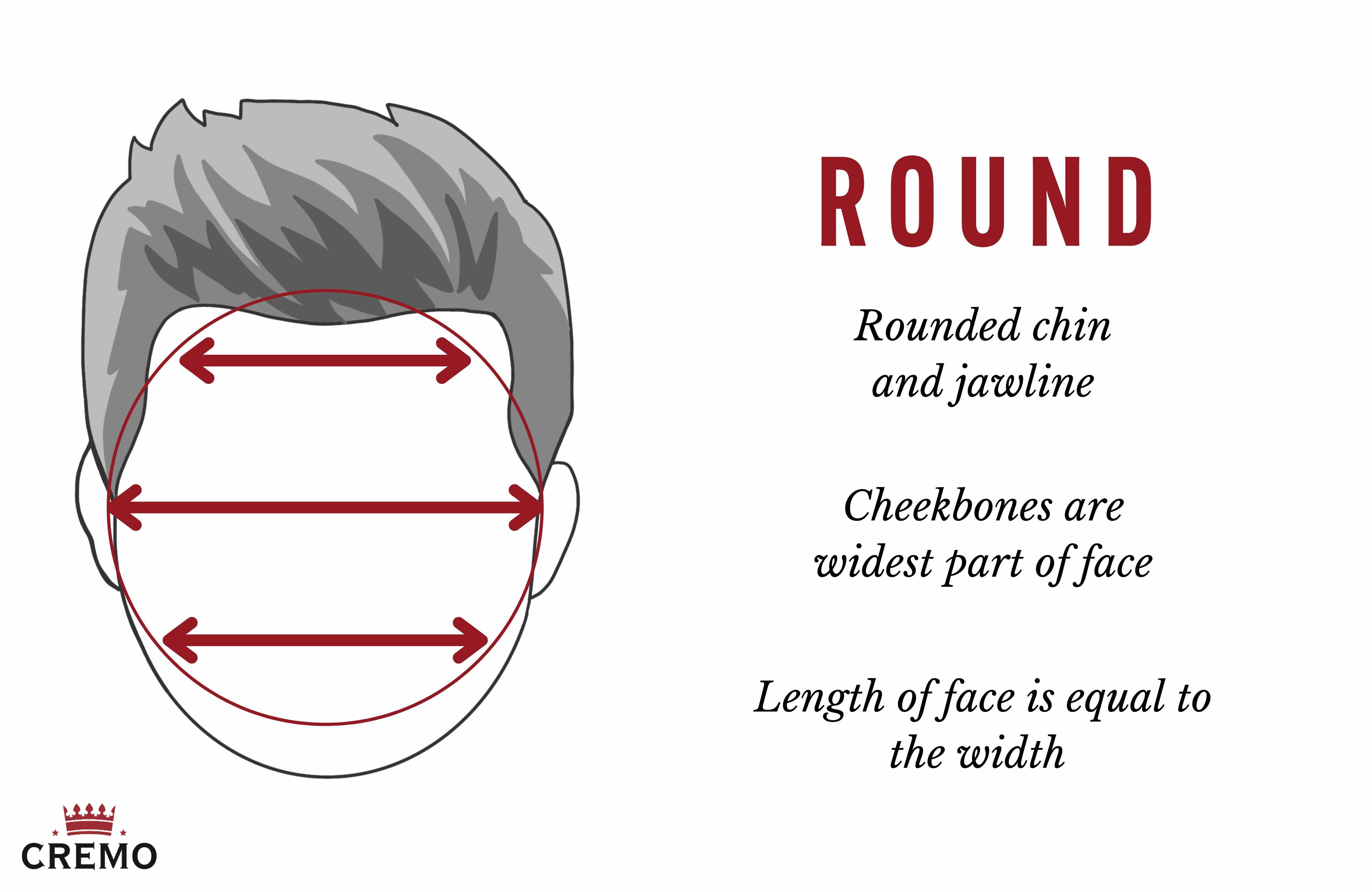
Diamond Face Shape
Men with diamond-shaped faces have wide cheekbones and narrow jaw and brow line. This face type benefits from having some facial hair. Choosing softer beard styles that add hair to the chin and width on the cheeks can offset the angular jaw and sharp cheekbones.
Characteristics: Pointy chin, cheekbones are the widest part of this face shape, narrow forehead and jawline
We Recommend: Full beard to expand the skinny jawline, a Goatee
Avoid: Styles like the ducktail, van dyke and anchor beard that end in a point as they just elongate and sharpen this face shapes existing features

Triangle Face Shape
This face shape does best with a style that adds width to the narrow jawline and helps fill out the small pointy chin. Keeping the sides of the beard short will avoid adding extra width to the already wide cheekbones.
Characteristics: Jawline measures broader than cheekbones, narrow browline, the jawline is the widest part
We Recommend: Beardstache and Longer stubble styles, Short Boxed beard, Garibaldi beard, Verdi beard, The Hollywoodian, and Classic Full beard
Avoid: Mutton Chops, Goatees, Van Dyke
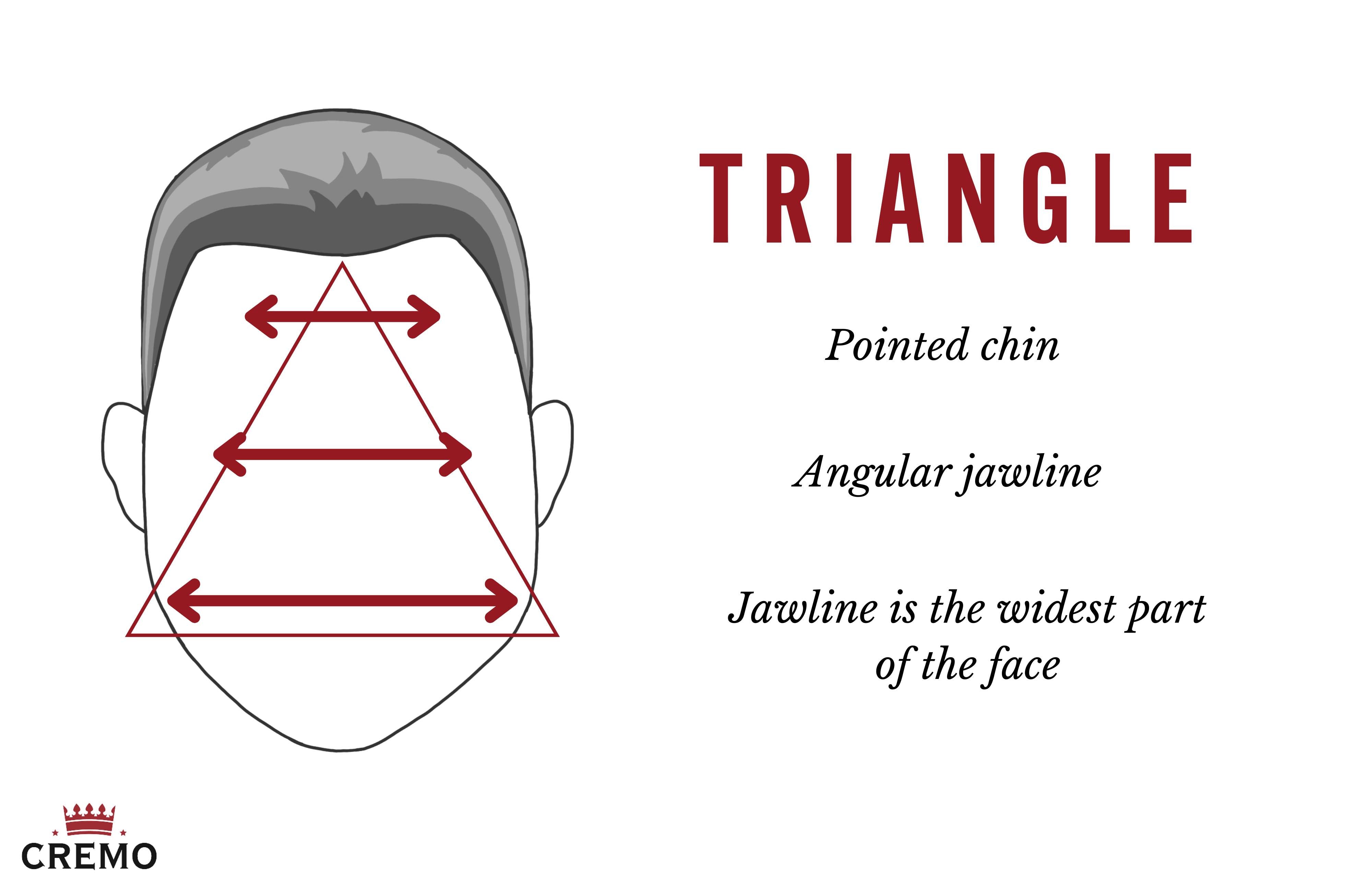
Heart Face Shape
This face shape has a relatively broad forehead and a narrow, pointed chin. Choosing voluminous beard styles that balance the more top-heavy proportions of this face shape. Full, heavy styles that add some bulk to the bottom of the face work best. Avoid styles that draw the chin to a point accentuating the features you are attempting to balance.
Characteristics: Cheekbone widest part of this face, narrow and pointed chin
We Recommend: Anchor Beards, Box Beards, Circle Beard, Full beard, Stubble styles
Avoid: Mutton Chops, Goatees, Ducktail or other beards that bring chin to a point, Van Dyke

Partial Beard Styles
Who Can Pull Them Off?
Partial beard styles are great for men with a square face or those with trouble with patchiness on their cheek areas. The shorter stubble length in these styles emphasizes the strong facial features that a longer beard covers.
These styles are popular since they don’t take as long to grow and require less maintenance than a full beard. However, since these styles are simpler with minimal facial hair, mistakes or missed areas will stand out more than other beard styles.
Beardstache
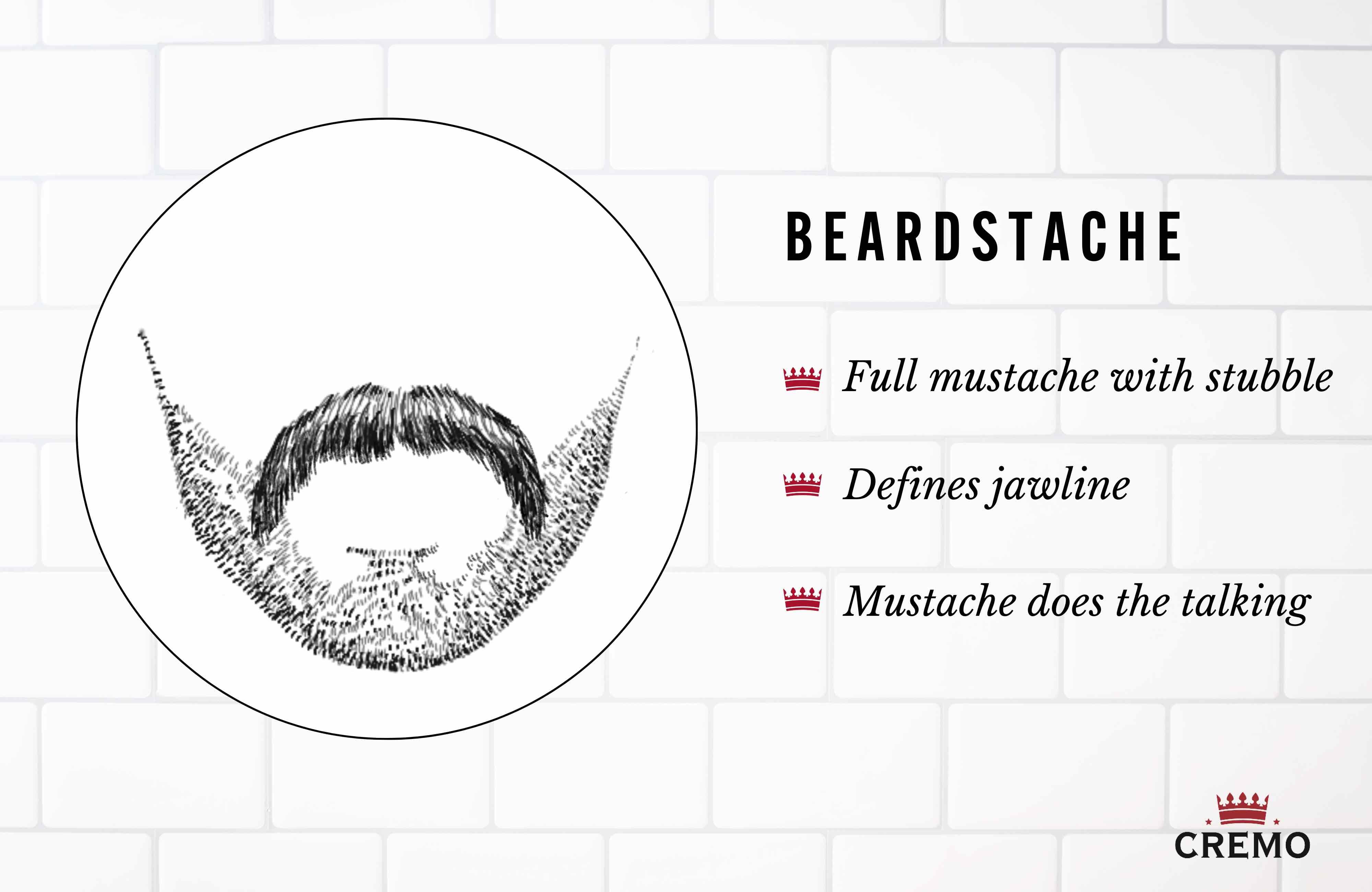
Can’t decide between a beard or a mustache? Cue the Beardstache, the perfect combo of both.
This modern and relaxed style focuses on a longer mustache with shorter hair on the cheeks, jaw, and chin, providing extra definition along the jawline while still letting your rock some longer facial hair. Experiment with your mustache's varying stubble length and thickness to find what flatters your features best. Chevron, lampshade, walrus, horseshoe, English, handlebar, and even Hungarian mustache styles work great with the beardstache.
Length Needed: You will need about 4-5mm of stubble and about 1-2 months of growth for the mustache.
Best For: Square or Triangle with a prominent jaw-line
Worst For: Round and Heart faces and those who have a thin mustache or small upper lip area
Shadow Goatee

It's no secret that standalone goatees with hair on the chin but not the cheeks are not for everyone. Keeping a five o’clock shadow on the cheeks and a goatee on the front can soften the look and create fullness. This style can work for thin or thick facial hair, easily hiding patchy areas with shorter lengths on the sides.
Length Needed: A few days of stubble, shorter than 5 mm on the cheeks, paired with a goatee of any length longer than the stubble
Best For: Square, Round, Oval, and Heart Face Shapes
Worst For: Diamond, Triangle Face Shapes since their chins are already prominent
Mutton Chops

For the man who wants to make an impression with his facial hair! You can love or hate them, but the classic mutton chops are backing a comeback. Born in the 19th Century, military men and generals used sideburns to stay clean-shaven while also sporting facial hair.
This style consists of bushy sideburns with a clean-shaven chin and around the mouth. Some variations, such as the Friendly Mutton Chops, include a mustache to connect the sideburns.
Length Needed: This style does require some volume, so you will need about 2 months of growth
Best For: Oval and Round Face Shapes
Worst For: Diamond and Heart shaped faces as their chins are already prominent
Anchor Beard
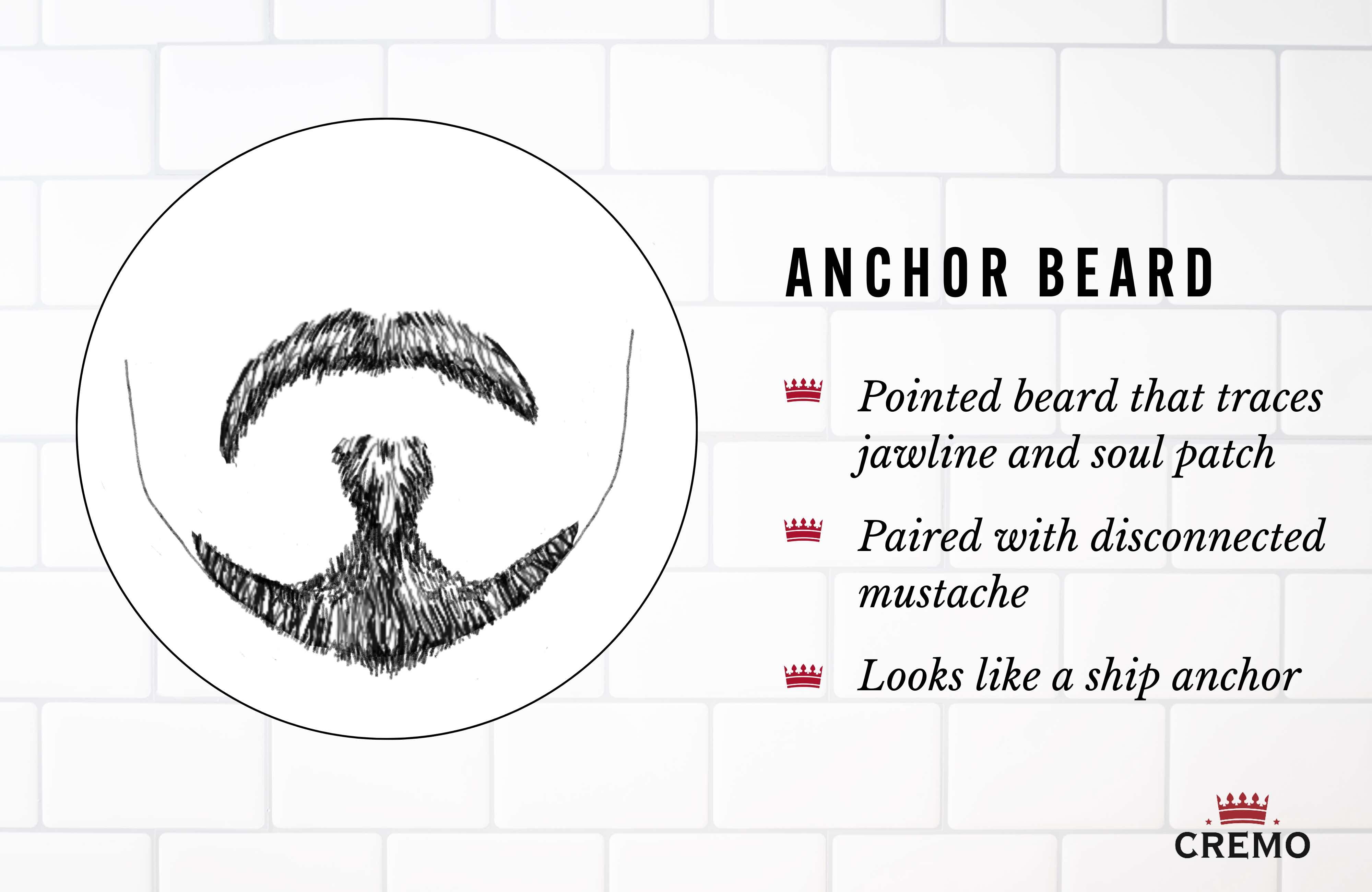
As you might have already guessed, the anchor beard gets its name from the nautical anchor and its shape’s resemblance to one. An Anchor Beard is characterized by a pointed beard that traces the jawline with a soul patch paired with a pencil or pyramid-shaped mustache disconnected from the hairs on the lower region of the beard. This style has no sideburns or cheek hair.
While its crisp, sharp lines give this style the reputation of being difficult, the results are well worth it.
Length Needed: About 2-4 weeks of growth
Best For: Oblong, Oval, and Square face shapes as it adds body and definition to the chin area
Worst For: Diamond, Heart shaped faces
The Van Dyke

One of the most common mustache and beard combos, this beard is named after Flemish painter Anthony Van Dyck. While it typically includes a disconnected pointy chin hair beard and a handlebar or imperial mustache, you can match this style with just about any mustache. This style is the perfect blend between a great mustache and an impressive beard resulting in a polished and stylish look.
Length Needed: At least 3-4 months of growth,at least 1.5 inches of growth needed; best to use a beard surrogate and then trim once there is the proper length
Best For: Oval and Square face shapes
Worst For: Oblong or Rectangle face shapes since a small patch under the chin could emphasize the largeness of the face
The Zappa

This eccentric style combines a thick mustache that extends past the corners of the mouth with a soul patch underneath the bottom lip. The width of this stache helps widen the appearance of the face for men with long or thin faces. Similar to the horseshoe style, however, the ends don’t extend down the face. As a bushy natural mustache, you won’t have to worry about trimming it too neatly.
Length Needed: It will take a solid three to six months of growth to get enough growth
Best For: Men with narrow faces like Diamond, Oval, and Square face shapes
Worst For: Long, slim face shapes like the Diamond and Oblong face shapes
Short To Medium Beard Styles
Who Can Pull Them Off?
A neatly trimmed short beard will suit most face shapes. The key is tailoring the angles of the beard lines to emphasize your best features and downplay your worst.
Bigger isn’t always better. These styles tend to be the most universal for various face types and occasions, whether formal or informal. Short to medium beards still allow you to show your individuality while keeping your beard neat and tidy.
The 5 O’Clock Shadow

The three-day stubble or a five o’clock shadow is one of the simplest and shortest beard styles. This style is achievable by growing facial hair for a day or two. The darker your facial hair, the quicker it becomes visible.
This “barely-there” beard style adds a little definition to the jawline and cheekbone without completely covering the face. Perfect for guys who aren’t able to grow thick facial hair without patches. Pair with a fresh haircut to create the perfect put-together look.
Length Needed: Only need .4mm of growth, which can be grown in a day or two
Best For: Most face shapes, particularly Square to show off the defined chin and jawline
Worst For: Diamond shape face as the shortness of hairs can exaggerate angular features and round face who need a little beard structure
The Scruffy/ Stubble Beard

If you want to try out a beard but are not ready to commit fully, the timeless stubble style is a great option. As one of the most straightforward beard styles, a stubble beard is achievable by growing facial hair for a few days or weeks after shaving.
It's important to remember that having a stubble beard is not simply the absence of shaving. You will still need to maintain your beard lines and use beard products to keep your beard looking its best. Use a clipper set between 1 and 1.5 to get that perfect stubble length and clean up your beard lines.
Length Needed: Depending on the length of stubble you are going, this style can take anywhere from a week or 4 weeks to grow. You will need between 2-5 mm of length for this style.
Best For: Square face shapes to accentuate their strong angular facial features; it can also help mature a round baby face instantly
Worst For: This style works on all face types but tends to work best with men who have darker facial hair versus blonde or ginger as it can tend to look unintentional
Verdi Beard

Named after the 19th Century Italian composer Guiseppe Verdi, this classic style with a distinguished appearance features a rounded 3-4 inch beard with short sides and a bushy mustache. As the focal point, mustache ends are waxed to hang over the top of the beard in a loose curl.
This style works on almost all face shapes. However, if growing a mustache is a struggle, you might want to check out some other styles for your beard.
Length Needed: 2-4” in length, 4-8 months of beard growth, potentially longer for the mustache length
Best For: With a rounded bottom adding bulk to the chin and jaw area, this beard works best withface shapes that have a narrow jawline and small chin likeTriangle, Heart, Diamond, or Round face shapes
Worst For: Face shapes that have wide jawlines like Oval, Oblong or Square face shapes
Faded Beard

Instead of keeping your beard all one length, this style requires tapering the hair around the sideburns and fading down towards the jawline. This smooth transition typically happens in two spots - the sideburn and face/cheek areas.
A good fade makes your beard look intentional instead of something that just grew out of your face. This versatile style can be tapered in different ways to complement your face shape or haircut. Removing the bulk on your cheeks helps slim and elongate your face shape by keeping the thickest part of your beard at your chin. Since fading can be tricky to master, you may want to consult a barber to get the precision needed to pull off this clean look.
Length Needed: Varies but looks best with your beard around 3-6 inches long
Best For: Square, Rectangle, Round Face, or Oval face shapes as it creates a narrow appearance without adding width to your cheeks.
Worst For: This style can be customized to work for any face shape
Hollywoodian Beard

As the name suggests, this beard was made popular by the actors of Hollywood in the 60s. This is the perfect choice when you’d like to grow a beard but don’t want it to hide your prominent facial features.
Easy to create and maintain, you can show off more of your face than a full beard, but it keeps you looking manly. This look includes the extended goatee, a full mustache, and a wide horizontal chinstrap tracing the lower jawline. Usually, there are minimal to no sideburns.
Length Needed: You will need 2-4 months of growth, or 1-2” inches of length, to style a Hollywoodian beard
Best For: Round Face to accentuate chin and jawline without adding width, Diamond, Triangle, and Oval face shapes to show off prominent cheekbones and define the jawline
Worst For: Square face shape as it covers up most defined parts of the jaw and chin
The Circle Beard

The goatee has been around for years, and most men find them easier to grow than full beards since no hair on the cheeks is needed. A circle beard is close to a goatee beard attached to the mustache forming a complete circle.
This clean look and short length make the style popular with working professionals. A circle beard is also highly versatile and looks good on most faces, from slim to round, balancing out facial features by elongating your face.
Length Needed: About 4 weeks of growth
Best For: Most face shapes but particularlyRound, Heart, Oval, and Square Face Shapes
Worst For: Diamond, Triangle Face Shapes
The Corporate Beard/ Short Boxed Beard

Who says beards aren’t business professional? The corporate beard is a close-cropped, well-maintained beard style that works for professional men in and out of the office.
This style is characterized by cheek lines that are straight or have an angular cut, and necklines are trimmed closer to the natural edge of the jawline than other styles. The entire beard is the same length leaving it looking sharp and clean.
A corporate beard is an excellent choice for any man who wants a full-face beard but doesn't like the volume or rugged look of the classic full beard. However, it does require dense beard-growing genetics as this length is short enough to show unevenness and patchiness for most men.
Length Needed: Usually trimmed to even½ to 1 inch, about a month of growth
Best For: Universally safe beard style, works well with Oval, Diamond, and Square Face shapes
Worst For: Round, Heart, and Triangle face shapes as they look best with a little length and width at the bottom of the chin and jaw
Long Beard Styles
Who Can Pull Them Off?
Once you have hit the 6-inch mark, you are officially in the long beard category. Not all men can pull off a thick and full long beard; as they say, you won’t know until you try! It’s best not to compare your beard with others; for some, long hairs become wispy and thin the longer they get. These styles can take a year or more to grow.
The longer the beard, the more maintenance and care are needed. It will be challenging to keep your beard looking good without regular brushing and combing. Beard products like beard wash, beard oil, and beard softener are also essential in keeping your beard healthy the longer it grows.
Classic Full Beard

A full beard is one of the most popular styles most guys aim for; however, it does require good facial hair genetics. A proper full-face beard covers the whole area where facial hair can grow, so you need hair covering your sideburns, chin, cheeks, and mustache. Maintenance for this beard style is relatively simple since you don’t need to trim too precisely and just keep up on simple beard products like beard oil and beard wash.
If you are having trouble growing a full face beard check out our guides to speed up beard growth and fix patchy facial hair. The shape and length of this beard are very versatile and can be customized to complement any face shape.
Length Needed: At least 2-4” of growth, which can take 4-8 months for the average man
Best For: Suits all face shapes, especially Round, Oval, and Heart face shapes
Worst For: Since you can shape and style this beard in so many ways, it can fit even the most difficult of face types
Full Beard With A Handlebar

The handlebar mustache became popular during the late 19th and early 20th centuries. They get their name from their resemblance to the handlebars of a bicycle.
The key to this style is allowing the mustache to grow out longer than usual while keeping the beard hairs just under the mustache a little shorter. The longer the strands, the more robust and curly the end of the handlebar will be. Applying wax to the ends of the stache with your fingers will create the definition you need to pull off the curled ends of this look and train your stache to lay the way you want.
Length Needed: You will need about 3 months of growth for the mustache and 4-8 months for the full beard
Best For: Oblong and Square face shapes
Worst For: Oval, Diamond, Round, Heart, and Triangle face shapes need softer mustaches
Ducktail Beard
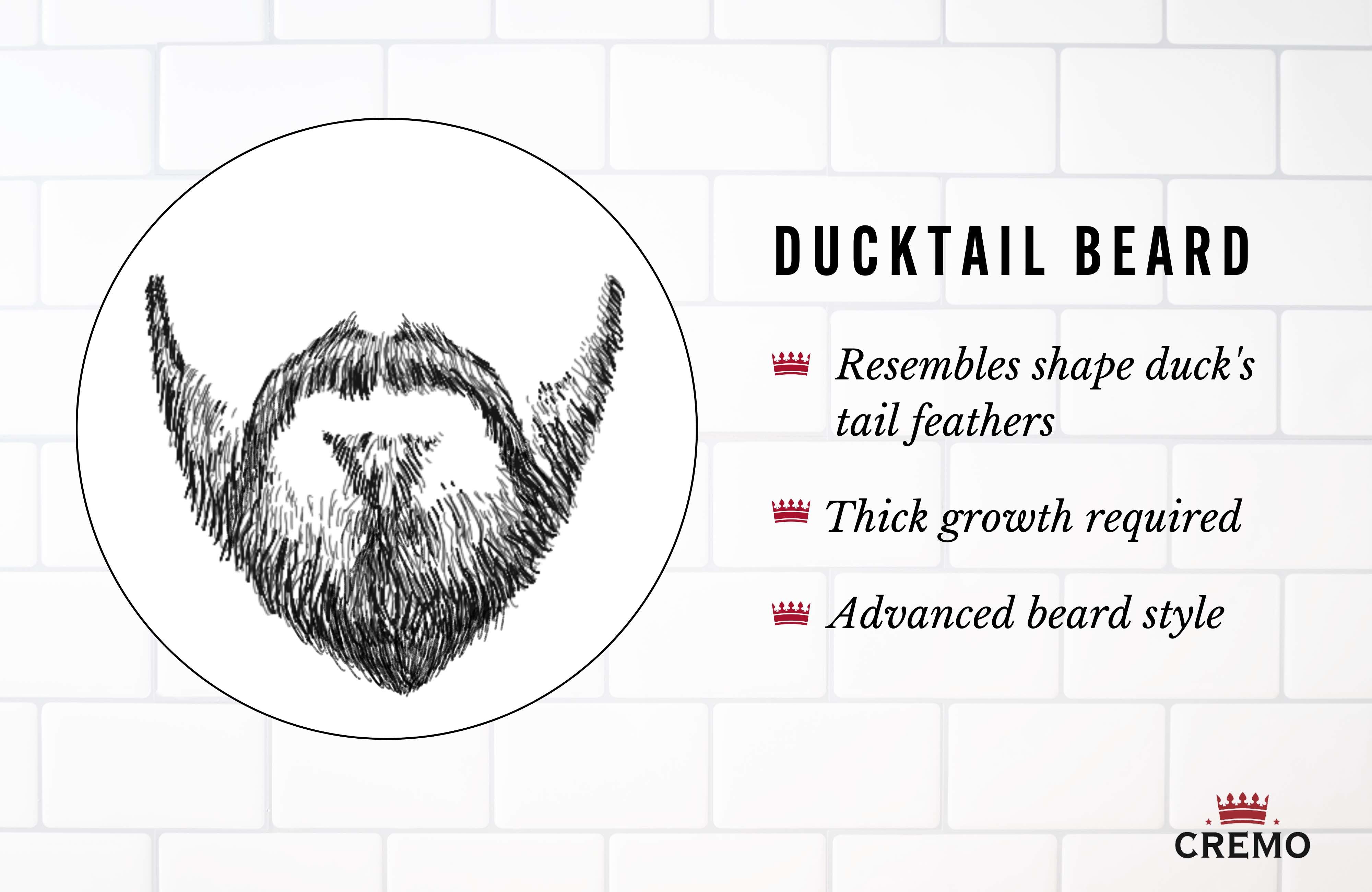
The Ducktail Beard is a full facial style whose end shape resembles a duck’s tail feathers. This beard style features short sides and a well-sculpted jawline that extends and connects to the chin at a point. The mustache area should be kept neat and trimmed.
While the name might sound a little goofy, this is an advanced beard style, and we recommend heading to your local barber for at least the first time you trim this style. You will need thick hair growth to shape this beard properly. Depending on your face shape, this beard can be worn at various lengths and shapes. If you struggle with patchy or thin beard hair, we recommend trying another beard from this list.
Length Needed: 2-4 inches in length, 4 to 8 months of growth
Best For: Diamond, Oval, Rectangle, and Round face shapes
Worst For: Triangle, Heart, and Oblong face shapes. These face shapes can still pull off this style; they just need to be careful not to draw too much attention to their already prominent chin
The Yeard

You might have heard of the yeard challenge. The idea behind the yeard, or a year-old beard, is no shaving or excessive trimming of your beard for 365 days, leaving you with a beard anywhere from 6” to 12” depending on your beard growth rate.
While you can trim off a fly-away beard hair here and there, no major trimming is allowed. This journey is a significant test of any man’s patience and self-control.
You won’t need your trimmer or a razor, but you will still need your other beard grooming products to promote growth and keep your beard hair and skin healthy. Keep your beard oil, beard wash/conditioner, and beard balm handy. Don’t forget to keep up on your brushing and add in combing as your beard gets longer.
Length Needed: On average, a yeard will grow to be 6” long but will vary between men based on their growth rates
Best For: Men with the patience and confidence to rock a sometimes scraggly and scruffy beard
Worst For: Square and Round face shapes since length and width can make these face shapes seem wider







